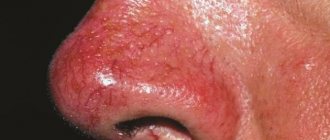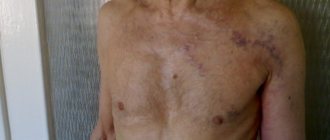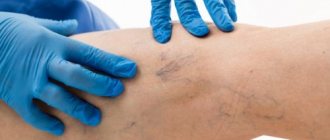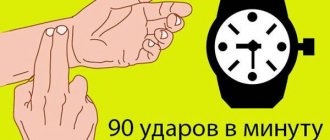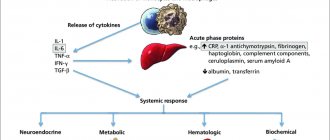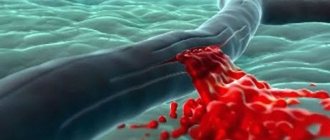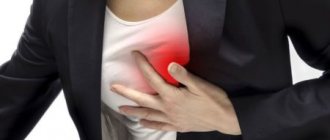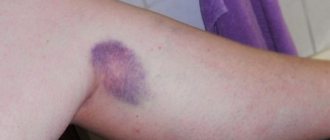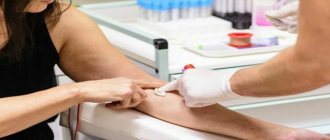Bruises on the body are usually formed as a result of excessive physical impact on a certain area. There is destruction of the capillary and release of liquid connective tissue into the dermis and subcutaneous fat.
The space is filled with blood, which looks like an unaesthetic green, bluish, yellow or other shade of stain.
It is incorrect to say that bruises appear on the body for no reason; there is a provoking factor. But it is not obvious to the patient himself, so it is impossible to determine what is to blame for the disorder without a specialized examination.
In typical cases there are no symptoms. If there is a group of manifestations from the hematopoiesis, blood vessels, heart, connective tissues, musculoskeletal system, the clinic should be considered as a potential part of any disease associated with the formation of hematomas on the body.
Therapy depends on the specific diagnosis. Many pose a danger to health and life. They require correction under the supervision of a hematologist, vascular surgeon, and other specialists.
Accidental undetected injuries
Often a person discovers a bruise and cannot determine the culprit. Although in fact there has been little physical impact on tissue in the recent past. Possible bruise or other forms of influence.
Depending on the structural features of the blood vessels, previous or current diseases, the intensity of the effect should be one or another.
It is interesting that the fragility of blood vessels may be the result of hematopoiesis and other pathologies. Then we need to talk about a mixed cause.
Specialized treatment is not required when it comes to an isolated disorder. It is enough to prevent injuries at home and at work.
Complications for minor bruises are also uncommon. Formed blood cells are quickly destroyed within a week, or even in a shorter time, everything returns to normal.
Etiology of bruises
To the above explanations of how a hematoma differs from a bruise, we can add the reasons why a person develops such formations. First, let's look at where bruises come from. Since they always form in the subcutaneous layer, their appearance can be caused by any injury that disrupts the integrity of small and medium-sized blood vessels located in the subcutaneous fat. These are:
- injury;
- hit;
- compression, squeezing;
- pinch;
- injection (bruises are observed with intramuscular injections, because the syringe needle touched and injured small vessels);
- intravenous injections (bruises are observed because blood has leaked from the punctured vein into the resulting space).
Bruises can appear on the legs due to varicose veins and phlebitis, and on the face after medical procedures, such as tooth extraction.
The weaker the walls of a person’s blood vessels, the more often and in greater numbers bruises “bloom” on his body.
Use of certain pharmaceuticals
Certain medications can cause bruising.
Typical groups of drugs that have this effect:
- Anti-inflammatory non-steroidal origin. They increase the permeability of vascular walls and cause capillary fragility. As a result of use, the formation of not one, but a whole group of hematomas of different localization is likely. In this case, the patient can track a clear cause-and-effect relationship. I took the drug and developed painless bruises.
- Antiplatelet agents. A group of pharmaceuticals for normalizing blood flow. They cannot be used without their intended purpose. These are all drugs based on Aspirin and some others, including modern analogues (more details in this article). Long-term use causes fragility of blood vessels, and changes in the physical properties of liquid connective tissue lead to the formation of large hematomas.
- Anticoagulants. Similar in effect to the previous ones, but more powerful. This is Heparin and other drugs of this kind. The rheological properties of blood change even more. Dangerous emergencies are possible. The tendency to form hematomas is an alarming sign. You need to think three times about the advisability of prescribing anticoagulants. And then decide on a specific name.
Other medications also have the ability to provoke minor bleeding. For example, hormonal, birth control pills, glucocorticoids, chemotherapy drugs for the correction of oncology, etc.
This is a side effect and is often indicated in the annotation. But perhaps we are talking about the individual reaction of the body to the active ingredient.
Treatment involves stopping a specific medication or using an entire class of medications.
Thrombocytopathies
A large group of disorders with similar clinical features. Usually these are hereditary pathologies associated with genetic abnormalities. But not always. Acquired species are also known.
They exist in two main forms. In the first case, normal activity of formed blood cells is observed with an insufficient number of them (thrombocytopenia). They die quickly or too few of them are formed.
The appearance of bruises on the body in this case is part of the whole. The clinical picture also includes nosebleeds, and the possible formation of small pinpoint scarlet nodules on the body. Especially in the legs, abdomen and groin area.
The second variant of the pathological process is a decrease in the functional activity of formed cells. The so-called thrombocytopathy.
It occurs somewhat less frequently than others. Is hereditary. Considered a more dangerous type. Because in addition to bruises on the body, hemorrhages in the joints, and even more dangerous processes, are found. Up to lethal.
However, pathologies associated with platelet dysfunction should not be confused with hemophilia. Formally, coagulation is not impaired. Remains normal. Although in some aspects the diseases are similar.
Therapy is urgently needed and involves long-term use of drugs. To prevent potentially fatal complications.
What can cause them to appear without bruising?
Doctors note that the causes of bruises on the body without contusions do not depend on gender or age; they can equally often appear in adults, adolescents or children.
Photo:
However, this phenomenon occurs more often in women and girls than in men. This is due to the physiological characteristics of the female body.
There are several main pathologies, the symptoms of which may be causeless subcutaneous hematomas:
- some types of vasculitis;
- varicose veins;
- decrease or loss of elasticity of the walls of blood vessels (Rendu-Osler disease);
- infections;
- oncology;
- systemic diseases of the tissue of the internal environment (or connective tissue);
- blood coagulation disorder;
- platelet deficiency;
- hormonal changes;
- taking steroids, medications that reduce blood clotting;
- avitaminosis.
Let us consider in detail the relationship between the formation of spontaneous bruises and the development of pathological processes in the body.
Poor blood clotting
There are more than ten established coagulation factors (blood clotting) involved with platelets in the hemostatic function.
Failure in hemostasis processes leads to coagulopathy (blood clotting disorder). This condition is characterized by frequent bleeding that is difficult to stop on your own. A striking example is hemophilia, a rare hereditary pathology.
Coagulopathy can be diagnosed after a biochemical blood test.
Hemophilia is incurable, but the disease can be controlled. Maintenance therapy includes blood transfusions, medications and diet.
With this disorder, bruises often remain even after a light touch.
Connective tissue diseases
This is a large group of hereditary pathologies, in which the most common are the following:
- Marfan syndrome;
- Ehlers-Danlos syndrome;
- elastic pseudoxanthoma;
- osteogenesis imperfecta;
- undifferentiated dysplasia.
A feature of this group of diseases is a violation of the synthesis of collagen (the main protein), which forms the walls of blood vessels. Because of this, the vessels become brittle and are easily damaged.
There are often cases when an infant or infant in the first year of life is covered with hematomas. As you grow and mature, symptoms progress.
There are no means yet to completely cure congenital defects of internal tissues. Treatment of patients is based on symptom relief.
The appearance of sudden bruises associated with a lack of collagen in the vascular wall is also possible in older people. This is due to the natural aging of the body, accompanied by a gradual loss of elasticity of the vascular walls and increased fragility of the capillaries.
Hormonal disbalance
Hormonal changes are usually observed in the female body during the following periods:
- the onset of menopause;
- carrying a baby;
- taking oral contraceptives.
Small bruises on the body for no reason in women can appear as a consequence of a decrease in estrogen levels, leading to a decrease in blood viscosity. Hormone deficiency is manifested by large, light-colored hematomas that disappear within 5 days.
If the hormone deficiency is at a critical level, hormonal medications are prescribed.
Hemorrhagic vasculitis
This type of vasopathy is otherwise called Henoch-Schönlein disease. The disease is accompanied by inflammation of the vascular wall followed by necrosis (destruction).
The first symptoms are observed in childhood (most often a child of primary school or a teenager).
The factors that provoke the development of pathology are varied - acute infections, autoimmune disorders, taking certain antibiotics, etc.
The main signs of hemorrhagic vasculitis:
- hematomas and rashes that appear just like that;
- formation of focal pigmentations;
- bruises are mostly located on the legs;
- swelling and pain from touching or pressing on the knee and ankle joints;
- deterioration of health, increase in temperature;
- Possible diarrhea and inflammation of the respiratory system.
Therapy is based on undergoing plasmapheresis, prescribing anti-leprosy drugs (Dapsone), anti-rheumatic drugs (Sulfasalazine), and glucocorticosteroids.
Thrombocytopathy and thrombocytopenia
This is a group of pathologies associated with impaired hemostasis.
Table of main pathological characteristics:
| Characteristics | Thrombocytopathy | Thrombocytopenia |
| Description | Congenital or acquired pathology. Characterized by a sufficient number of platelets and inferior cell quality. | On the contrary, the cells function normally, but there is a lack of their number. |
| Symptoms | Bruises without contusions of any size. Hemarthrosis (bleeding in the joints). Severe bleeding with the slightest damage to the skin and mucous membranes. | Frequent nosebleeds (or mucous membranes). Multiple, large subcutaneous hematomas. |
| Treatment | Taking hemostatic drugs (Vicasol, Benefix, Immunin). | Taking steroid hormones. Surgery to remove the spleen results in recovery in 80% of patients. |
| Forecast | Full recovery is impossible. Severe, prolonged bleeding can be fatal. | Conditionally favorable. |
Impaired platelet levels can provoke changes in blood composition and the development of thrombosis.
Rendu-Osler disease
This is congenital telangiectasia, which is characterized by an abnormal structure of blood vessels and dilatation of small vessels, manifested by hemorrhages.
The main symptom of Randu-Osler syndrome is hematomas or vascular networks (asterisks) of different diameters and locations that appear for no reason. The largest accumulation of pigmented lesions is observed on the face and internal organs (respiration and digestion).
Any physical stress provokes the formation of new hematomas. Most patients experience frequent nosebleeds.
Therapy includes taking hemostatic and healing agents. Despite its incurable form, the disease does not threaten the patient’s life.
Taking steroid drugs
One of the side effects from taking glucocorticosteroid drugs prescribed for various disorders (for example, autoimmune) is purpura.
This is a symptom manifested by increased capillary fragility with subsequent formation of subcutaneous hematomas. The condition does not threaten the patient’s health, as it is easily corrected by discontinuing or reducing the dosage.
Phlebeurysm
With this pathology, there is an accumulation of subcutaneous hematomas with limited localization. Bruises appear only on the legs, which indicates the formation of stagnant processes in the vessels and the development of varicose veins.
The disease is accompanied by the following symptoms:
- the appearance of bruises and vascular networks (stars);
- protrusion of individual areas in the veins of the lower extremities;
- swelling, which may cause pain in the legs when walking;
- convulsions.
Due to the obstruction of the outflow of venous blood, the vessels become overfilled, which causes tearing of the vascular wall and the formation of small bruises.
When the first signs of the disease appear, it is recommended to immediately consult a phlebologist to prevent the spread of unpleasant symptoms.
Side effects from taking medications
Long-term use of certain types of drugs can provoke the formation of subcutaneous hematomas on the face, arms and legs, shoulders, abdomen and other parts of the body.
The group of such medications includes:
- antiplatelet agents (aspirin);
- anticoagulants (heparin, warfarin).
It is recommended to temporarily exclude physical activity and prevent hypothermia of the body, as they contribute to the appearance of bruises.
Lack of vitamins in the body
Acute vitamin deficiency often leads to the appearance of spontaneous bruises on the body.
We are talking about a deficiency of the following vitamins:
- Vitamin P - deficiency causes collagenosis (impaired collagen synthesis). This leads to permeability of the vascular walls and capillary fragility.
- Vitamin K - deficiency provokes coagulopathy (blood clotting disorder). Any damage to the skin (scratches, cuts), even slight tears in blood vessels lead to prolonged bleeding, impaired wound healing, and bleeding gums.
- Vitamin C - deficiency causes increased fragility of blood vessels. As a result, tissue regeneration slows down, calcium deficiency, hair loss, etc.
A deficiency of ascorbic acid (vitamin C) can cause serious illness. For example, scurvy is a severe metabolic disorder, the main symptom of which is the sudden appearance of subcutaneous hematomas.
The main expressed symptoms of scurvy:
- loose bleeding gums;
- severe loosening of the crowns, up to the loss of the entire dentition;
- development of various types of anemia;
- severe pain in muscle tissue due to the formation of massive hematomas.
Replenishing the deficiency can easily be corrected by prescribing vitamin injections.
Infectious pathologies
It is believed that in most cases (up to 80%), spontaneous hematomas occur against the background of previous viral infections. This is especially true for the development of the above-described hemorrhagic vasculitis.
Even common respiratory diseases (tonsillitis, flu, adenoiditis, etc.) can cause bruises in different parts of the body (neck, hips, back).
Oncological diseases
Periodic manifestations of subcutaneous hematomas without bruises are often the body’s reaction to the development of a malignant process.
The appearance of hematomas in this disease often occurs with damage to the bone marrow and liver.
Liver failure
Liver lesions often cause a deficiency of clotting factors.
The liver is one of the main organs that ensures the maintenance of hemostasis processes.
Liver failure is a severe disorder that causes thinning of the blood and, as a result, the formation of subcutaneous hematomas.
Deficiency of clotting factors
It is relatively rare. The reason is the initial defectiveness of those substances that are designed to cause coagulation. A total of 10 such compounds are known.
But all pathological processes of this kind are similar. The most typical representative is hemophilia.
The causes of development are always pathogenic, congenital.
There are no specific manifestations. There is the formation of bruises in the abdomen, limbs, and throughout the body, profuse internal bleeding and effusion of liquid connective tissue into the joints.
Diseases associated with coagulation factor deficiency cannot be completely cured. Because there are no reliable methods other than transfusions yet.
Also difficult to diagnose. Requires expensive equipment.
Forecasts are usually conditionally unfavorable. But there is always a chance for correction and compensation.
Vasculitis
A large group of diseases in which inflammation of the walls of blood vessels is observed, their destruction and bleeding into the surrounding space.
Both capillaries, veins, and arteries are affected. Without therapy, the pathological process is extremely dangerous and can lead to the death of the patient from massive bleeding.
There are many types of disorder known. The location of the hematoma depends on which area is involved. With inflammation of the vessels of the upper extremities, bruises are found on the arms, etc.
Multiple bruises develop against the background of systemic vasculitis. This is a generalized form in which a group of vessels of different locations is affected.
The clinical picture is quite specific, regardless of the form and type of disease:
- Headache, spatial disorientation, weakness, drowsiness, bone aches. A rise in body temperature to high levels is possible and often occurs (the intensity of hyperthermia depends on the characteristics of the body and the aggressiveness of the process).
- Formation of bruises and hemorrhagic rashes on the skin. Usually at the same time. Gradually, the defects ulcerate and then heal on their own. Hyperpigmentation forms and appears as a bluish patch or purple area. This is unaesthetic, but can be corrected with medications. Ointments for topical use. The development of the symptom is spontaneous. The specific moment is not determined. In this case, the rash is more common in the lower extremities.
- Pain in the joints of the legs. Ankles and especially knees suffer. A decrease in motor activity, discomfort and heaviness, and redness are also detected. An increase in local temperatures is possible. A mandatory sign is swelling.
What is the reason for this “love” of vasculitis for localization in the lower extremities? The reason is the peculiarities of hemodynamics (blood flow). Here it is most intense, and the vessels themselves experience enormous stress.
- Hemorrhages are possible in the joints of the legs, less commonly the arms. Symptoms intensify, pain becomes more intense. These are the main manifestations of the disorder. It is difficult to detect the problem on your own. Only with significant volumes of liquid connective tissue effusion.
The pathology poses a great danger, especially with an aggressive course. It usually occurs in response to an infection in the recent past.
Less commonly, it is primary, caused by autoimmune pathological processes.
Therapy in a hospital or at home depends on the severity of the disorder. Read more about the types of vasculitis and methods of its treatment in this article.
What are small hemorrhages on the skin?
Hemorrhage under the skin occurs when capillaries rupture. Due to the small amount of blood in the thinnest vessels, the spots will be within millimeters in size. Usually there is a single localization of such points. A person does not feel a deterioration in health, and may not even be aware of the presence of petechiae on the skin.
To understand that a skin rash is damage to the capillaries, and not an allergy, it is enough to press on that place - the spots do not change color and do not disappear. After some time, the formations will lighten and then disappear.
Purpura
Such an unusual name hides the formation of hematomas, bruises on the skin for no apparent reason. This is not the disease itself, but a symptom.
The disorder usually develops against the background of long-term use of glucocorticoids in high dosages. The fragility of blood vessels increases, and problems with clotting arise.
There are no symptoms as such. Massive bleeding and other life-threatening consequences occur extremely rarely. At the level of statistical error. Therefore, there is no specialized therapy and is not required. The forecasts are favorable.
Pediatrician appointment prices:
| Appointment (examination, consultation) with a pediatrician (1 hour) | 1950 |
| Examination of a child by a pediatrician to obtain a certificate + certificate | 1750 |
| Appointment (examination, consultation) with a pediatrician of the first category, head. department Barzenok T.A. | 2850 |
| Registration of a certificate | 700 |
| Appointment (examination, consultation) with a leading pediatrician (Sedova M.S.) | 2500 |
| Appointment (examination, consultation) with a pediatrician, head of the breastfeeding support department, Kazakova L.V. | 2950 |
| Appointment (examination, consultation) with a pediatrician (Premium category) (Sergienko T.Ya.) | 4000 |
| Visit of a pediatrician, consultation at home (Moscow) | 4250 |
| Consultation with a pediatrician at home for the second child | 1950 |
| Visit to the home of a pediatrician, head of the breastfeeding department, Kazakova L.V. | 4250 |
Congenital pathologies
As a rule, we are talking about developmental defects of genetic origin. This includes a large group of violations. From Marfan syndrome to osteogenesis imperfecta.
Unreasonable bruises and bruises on the body are a minor problem compared to other signs of pathological processes.
Thus, massive disturbances in the formation of bones, the entire musculoskeletal system, and deviations in mental development are observed. Depends on the specific diagnosis.
Usually the pathology becomes visible as soon as the child is born. Sometimes diagnosis lags behind, and the problem becomes more urgent as one gets older.
The reasons lie in disruption of intrauterine development in the early stages, even at conception and a little later. It is almost impossible to detect by ultrasound or other methods; there are effective screening methods, but they are inaccessible, expensive and you need to seriously look for a clinic that provides such a service.
Therapy consists of eliminating the main symptoms. It will not be possible to radically influence the condition.
Prognosis depends on the diagnosis and includes both relatively mild conditions and hopeless situations when even symptoms are difficult to relieve.
The mechanism of bruising
It's very simple. At the site of the injury, micro-ruptures of blood vessels occur in the upper layers of the skin, and hemorrhage occurs into the soft tissues. Blood entering the tissue forms a bruise. Initially, the injured area is red or purple, but as the hemoglobin in the blood is destroyed, the bruise changes color. Colors may vary:
- purple-black;
- purple;
- blue;
- black;
- when the bruise begins to fade, its coloring acquires yellowish tints.
This happens due to the release of bile pigments - bilirubin (red), biliverdin (green).
On a note! The “life” cycle of a hematoma depends on the degree of vascular damage and the level of blood supply to the tissues.
The stronger the blow, the greater the injury, the darker the bruise. The better the blood supply to the area, the faster the bruise will disappear. If bruises appear on the body for no reason, this is a reason to consult a doctor.
Scurvy
A rare disease these days. Represents a deficiency of vitamin C in the body. The body is not able to synthesize it; it comes from food.
Therefore, the cause of the violation is most often nutritional. Or there is insufficient absorption of the compound in the digestive tract. The first is much more common.
The symptoms are severe. Because the intensity of collagen production decreases. A binding protein that gives strength and elasticity to the skin and connective tissue to the walls of blood vessels.
The clinical picture includes the formation of many bruises. Loosening of teeth as a result of weakening gums, their loss. Painful sensations in the muscles.
Therapy is not very difficult in most cases. There is no need to hospitalize a person in a hospital.
However, if the situation is neglected, there is a high probability of massive bleeding and death.
This is unlikely. But you shouldn’t delay visiting a hematologist.
Attention:
Some toxic diseases can be disguised as scurvy. For example, lead and mercury poisoning.
These are also relatively rare conditions, most often caused by the patient’s professional activities. Diagnosis and treatment are carried out under the supervision of a hematologist.
Hereditary diseases
The classic diagnosis of this group is Randu-Osler syndrome. This is a rare deviation, which is caused by a violation of the formation of the muscle layer of the vascular wall.
Massive small bleeding occurs throughout the body. Outwardly, they look like small scarlet nodules protruding above the surface of the dermis, bruising on the skin for no reason, and small bruises.
The disease accompanies a person throughout his life. As a rule, small vessels and capillaries are affected. Therefore, massive bleeding and dangerous complications do not occur.
The pathology is fraught mainly with a cosmetic defect. Therapy can reduce the activity of the disease and partially strengthen blood vessels.
There are still reasons for the formation of bruises on the body. Another thing is that they cannot be detected on your own. You need to go to see doctors to assess the condition of the body from different positions.
The process may not be quick. From a week to several months of dynamic observation.
How to quickly remove bruises
If the hematoma is just beginning to appear and has a purple tint, it is recommended to apply a cold compress to the affected area or place the limb under a stream of low-temperature water. If more than 24 hours have passed since the bruise formed and no swelling is observed, you should warm the salt, wrap it in a cloth and apply it to the injury. Warming enhances the process of cellular regeneration and improves local blood circulation. To obtain maximum effect, it is recommended to apply salt 3 times a day for 15 minutes.
Important information: Why does a hematoma of the auricle appear in humans and how to treat a bruise on the ear
To quickly remove a bruise, you can use a menthol compress. To do this, you will need to soak gauze or soft cloth in an alcohol solution of menthol. It is necessary to apply the product 3 times and hold for 15-20 minutes.
Ointments
To remove bruises, you can use medications for external use, these are:
- Heparin ointment.
- Gel Troxevasin or Troxerutin.
- Lyoton.
Medicines have a cooling effect due to the content of plant extracts and menthol. Due to the active ingredients, the blood clots faster, the capillaries narrow and local blood circulation improves. To quickly remove blood from soft tissues, dermatologists recommend using products with leech extract. Ointments with an analgesic effect - Ibuprofen, Fenistil or Ketoprofen - can relieve severe pain.
Traditional methods
Alternative medicine helps to quickly get rid of bruises:
- Compress of onion porridge with table salt. To prepare the product, you need to grind the onions in a blender or chop with a grater. After completing the manipulation, you need to mix the ingredient with 1 tbsp. salt. The mixture will need to be wrapped in cloth gauze. To reduce the hematoma, the resulting product must be applied to the affected area for 30-60 minutes 3 times a day.
- Flower tincture of horse chestnut. This remedy helps people remove bruises on the body within a week with regular use. The tincture strengthens the walls of blood vessels, which is why it is recommended as an additional treatment method for varicose veins of the lower extremities.
- Cabbage. The leaves of the vegetable must be beaten with the back of a knife until the juice is obtained. After this, you only need to apply the cabbage to the hematoma and hold it for 30 minutes. Using a similar technology, you can use plantain leaves. In this case, before using leafy greens, you need to rinse them thoroughly with running water.
- Alcohol tincture or decoction of wild rosemary. To eliminate bruising, you need to rub the affected area or apply a gauze compress 2 times a day.
Compresses soaked in arnica infusion are used as an effective treatment for hematomas. To prepare the decoction you need 1 tsp. flowers, pour 250 ml of hot water and leave for 2 hours under a closed lid. Before use, it is necessary to strain the infusion and moisten a gauze cloth with it. The compress should be applied to the bruise for 20-30 minutes daily. To strengthen the vascular walls, you can drink the product 3 times a day before meals.
Necessary examinations
Diagnosis is carried out under the supervision of a hematologist and vascular surgeon. If necessary, other specialists are involved.
Approximate list of events:
- Patient interview. To understand what complaints the person came with and to create a complete clinical picture. Depending on this, the doctor moves on.
- Anamnesis collection. Previous pathologies, lifestyle, hereditary history and others.
- Blood tests. General analysis, coagulogram (clotting test), assessment of other indicators. It is important to detect deviations in composition, physical and chemical characteristics. This is one of the key surveys.
- Vascular ultrasound. If necessary, other visualization methods. To consider the anatomical features of capillary networks, veins and arteries.
As part of an extended diagnosis, consultation with an endocrinologist is indicated. Factors in the development of insufficient coagulation or other problems with the circulatory system can also be hormonal.
It is necessary to check the level of specific substances in the body. A comprehensive examination provides a fundamental basis for prescribing therapy and further assessing the dynamics of the pathological process.
Treatment
To get rid of hematomas forever, you need to find out the root cause and get rid of it. A therapist and highly specialized doctors can help with this: phlebologist, hematologist, endocrinologist and oncologist.
To get rid of bruises, ointments and gels are used that improve metabolic processes. Such means include:
- cream "Rescuer"
- badyaga,
- gels with leech extract,
- heparin and troxevasin ointments.
These products should be applied with gentle, stroking movements so as not to damage nearby vessels.
Simultaneously with local treatment, the patient is prescribed drugs containing flavonoids. These substances increase the strength of the walls of blood vessels. These include vitamin C, rutin, hesperidin. The first 2 are part of ascorutin, known to everyone as “ascorbic acid” in yellow sweet and sour balls. A natural alternative to this drug is citrus fruits.
Treatment methods
Correction methods depend on the cause of the disorder and the occurrence of bruises. It is necessary to proceed from the mentioned problems.
| Disease | Treatment |
| Hereditary pathologies such as Randu-Osler syndrome. | They are not cured. Drugs are prescribed for resorption of bruises (Heparin topically in small quantities) and wound healing drugs (Solcoseryl and others). And so on according to the testimony. |
| Scurvy. | Requires the introduction of vitamin C or improvement of its absorption by the body. |
| Congenital pathologies. | They are not treatable at all. Symptoms have been managed with varying degrees of success. But many patients have significantly limited life or the duration of life is minimal. |
| Purpura. | Involves discontinuation of glucocorticoids. Then everything returns to normal on its own. |
| Vasculitis. | Prescribe glucocorticoids, if necessary Sulfasalazine, cytostatics to reduce the intensity of the immune response. Infectious forms require the use of antibiotics. |
| Deficiency of coagulation factors. | Blood transfusions, but this is a symptomatic measure. Can't help radically. |
| Thrombocytopathy. | Involves the use of hemostatic drugs and steroids. In severe cases, removal of the spleen is indicated. The names of the medications are determined by the doctor. |
| Effect of medications. | Presumably rejects them. |
The goal of therapy is not achieved immediately. Course selection required.
How to remove hematomas?
After establishing the nature and characteristics of the hematoma, treatment is prescribed in accordance with the information received:
- prescribe UHF procedures;
- a surgical opening is performed to remove accumulated clots and rinse the cavity;
- the patient is hospitalized in the surgical department for opening and drainage, followed by antibiotic therapy.
Recovery time depends on the extent of the lesion, the presence or absence of infection and other factors.
